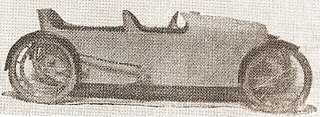Related Research Articles

Bédélia was the archetype of the French cyclecars.

David was a Spanish company manufacturing automobiles in Barcelona between 1913 and 1923 and again between 1951 and 1957.
The Bantam was a British cyclecar manufactured by Slack and Harrison in Kegworth, Leicestershire in 1913.

Coventry Premier Limited owned a British car and cyclecar manufacturing business based in Coventry from 1912 to 1923. It changed its name from Premier Cycles to Coventry Premier Ltd in November 1914.

The GWK was a British car made in Maidenhead, Berkshire, between 1911 and 1931. It got its name from its founders, Arthur Grice, J. Talfourd Wood, and C.M. Keiller. The cars were unusual in using a friction drive system.

The GN was a British cyclecar made in London, between 1910 and 1925, The name derived from its founders, H.R. Godfrey and Archibald Frazer-Nash. Production ceased in 1923 but the company kept trading until 1925.
The Gray Light Car was a cyclecar built in Longmont, Colorado, in 1920 by H A Gray. Only two prototypes were made and, though articles of incorporation for the Gray Light Car Corporation were filed in July, it never reached production. Company officers were given as Gray, H M Koutz, G E Gumston, E J Kiel, and J H Vickery. Koutz and Keil were cigar manufacturers.
Grahame-White was an early British aircraft manufacturer, flying school and later manufacturer of cyclecars.

The Blériot-Whippet was a British 4 wheeled cyclecar made from 1920 to 1927 by the Air Navigation and Engineering Company based in Addlestone, Surrey.
The Bound was a British 4 wheeled cyclecar made in 1920 by Bound Brothers of Southampton, England.
The Engler was a cyclecar manufactured in Pontiac, Michigan by the W.B. Engler Cyclecar Company from 1914 to 1915. The Engler was a two-seater cyclecar that used a DeLuxe air-cooled, a 1.2L two-cylinder engine. The vehicle had a friction transmission and belts, and cost $385.

The Little Princess was a cyclecar built in Detroit, Michigan, by the Princess Cyclecar Company from 1913–14.

The Mercury was a cyclecar built in Detroit, Michigan, by the Mercury Cyclecar Company at 807 South Scotten Street in 1913-1914.

The Partin Manufacturing Company was a brass era American automobile manufacturer, headquartered at 29 South LaSalle Street, Chicago, Illinois from 1913 to 1917. The Partin-Palmer automobile and Pioneer cyclecar were produced.

The Campion Cycle Company was a British bicycle, cyclecar and motor cycle maker, active from 1893 to 1926 and based in Nottingham, England. In 1927 it was purchased by Currys.
The Economic was a British three-wheeled cyclecar made from 1919 to 1922 by Economic Motors of Wells Street, London, W1. It was, at £60, almost certainly the cheapest car on the British market at the time.

The HP was a British three-wheeled cyclecar made from 1926 until 1928 by Hilton-Peacey Motors of Woking, Surrey.

The Warren-Lambert Engineering Co. Ltd. was a British automobile manufacturer that was established from 1912 to 1922 in Richmond, then in Surrey. A. Warren Lambert, was an agent for Morgan cars in Putney which he also raced. In 1912 he designed and started to manufacture a two-seat four-wheel cyclecar from premises in Uxbridge Road, Shepherd's Bush. It was well received and around 25 cars a week were being made.
The Brass Era Rex cyclecar was manufactured by the Rex Motor Company in Detroit, Michigan in 1914.

The Saginaw cyclecar was built by the Valley Boat & Engine Company of Saginaw, Michigan in 1914.
References
- 1 2 G.N. Georgano, N. (2000). Beaulieu Encyclopedia of the Automobile. London: HMSO. ISBN 1-57958-293-1.[ page needed ]